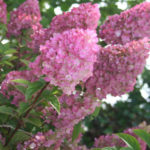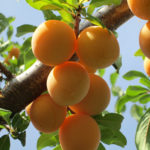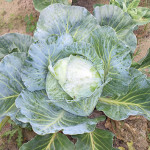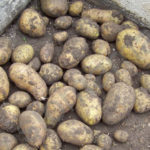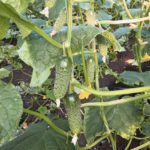Apple variety Orlik
The Orlik variety was bred at the Orlovskaya zonal fruit and berry experimental station in 1959 by crossing the varietal apple trees Mekintosh (Mackintosh) and Bessemyanka Michurinskaya. Its authors are domestic breeders Sedov E.N. and Trofimova T.A. About 10 years have been spent on improving this variety, as a result of which the indicators of frost resistance and fruiting have increased significantly. In 1968, the seedling was allocated to the elite, and in 1970 Orlik was admitted to the State test. Since 1986, the variety has been zoned in the Central, Central Black Earth, and also in the North-West region. The new apple variety was rapidly gaining popularity not only among private farms, but also among industrial enterprises. The key to this success was the compact size of the apple trees and high yield rates.
The apple tree Orlik belongs to the varieties of the winter period of fruit ripening. The trees grow small to medium in size, the crown is round and compact. The main branches are located at right angles to the trunk, their tips are slightly raised upward. The bark on the trunk and main branches is smooth to the touch, with a yellowish tinge. Mainly simple and complex ringlets bear fruit.
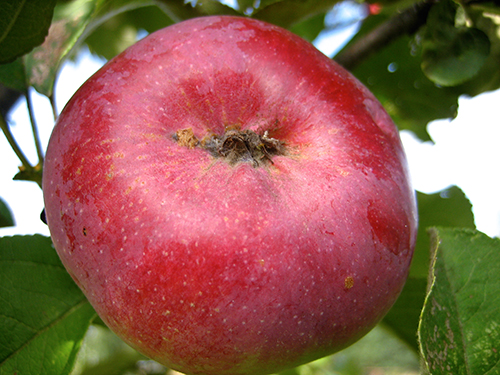
Shoots are straight, thickened, brown, high pubescence. Buds are medium, conical, strongly pressed to the shoots, pubescent. Leaves of rich green color, rather large, oval, wrinkled, with pronounced venation, densely sit on the shoots. Due to the strong pubescence, the leaves acquire a grayish tint. The edges of the leaf plate are coarse and coarse. The leaf is slightly curved along the central vein, the surface is almost flat. The tips of the leaves are sharply pointed and slightly curved. Petioles are thickened, pubescent, colored at the bases, can be short or medium in length. Stipules are small, lanceolate, or even absent. Internodes are rather short provided there is sufficient light. In the spring, Orlik apple trees attract attention due to their beautiful, abundant flowering: the buds are bright pink, and the already blossoming flowers acquire a pale pink hue. The size of the flowers is large, the petals are closed, the stigmas of the pistils are located below the anthers.
As a rule, Orlik apples are medium in size, the weight of one fruit is about 100 grams, but can reach 200 grams. The apple is round, slightly conical, slightly flattened. Large lobes are poorly expressed. The skin is shiny, oily, covered with a characteristic whitish waxy bloom. The main color of the fruit during picking is greenish-yellow, after a short storage it becomes light yellow. On the entire surface of the apples, an integumentary purple color passes in the form of a thick, blurred blush and merging stripes. Completely red fruits are sometimes found. On the peel of an apple, it is easy to see numerous subcutaneous dots of small size, with a grayish tint. The structure of the fruit is fine-grained, rather dense. The peduncle is thick, short, with a pronounced influx at the point of attachment to the fetus. Apples with a shallow saucer, slightly folded, of medium width and with a closed or half-open cup. The funnel is shallow, floating, practically free of rustiness. The heart is medium in size and heart-shaped. Seeds are dark brown, ovoid, well-executed. The seed chambers are closed.
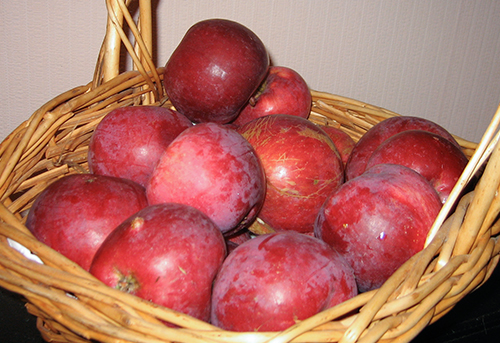
The flesh of the fruit has a creamy color and a slightly greenish tint. Orlik apples are very juicy, with a harmonious sweet and sour taste (slightly sour taste) and a pleasant, strong aroma.Assessment of the taste of the fruit on the tasting scale is 4.4 - 4.6 points. In terms of chemical composition, Orlik apples contain: sugars (11%), titratable acid (0.36%), pectin substances (12.7%), ascorbic acid (8.9 mg / 100 g), P-active substances (167 mg / 100 g).
The fruits ripen by the second half of September; with proper storage, the consumption period can be extended until the end of February - early March. The Orlik variety is distinguished by its early maturity and high yield. On a medium-sized rootstock, fruiting begins 4 to 5 years after planting. The yield increases rapidly with each subsequent year: from 15 to 35 kg of fruits ripen on a 7 - 8-year-old apple, from 55 to 80 kg on a 10 - 13-year-old tree, and from 80 to 120 kg on a 15 - 20-year-old tree.
Winter hardiness of the Orlik variety is high, but in severe frosts, it is recommended to wrap up the trunks. Scab damage is average.
Orlik apple trees are ideal for small garden plots - seedlings are planted at a distance of 2 meters from each other.
Due to the excellent dessert qualities of apples, as well as the possibility of long-term storage and high transportability, the fruits are used for nutrition in kindergartens and in the manufacture of juices.
Among the main disadvantages are the frequency of fruiting and partial shedding of apples before the harvesting season.
